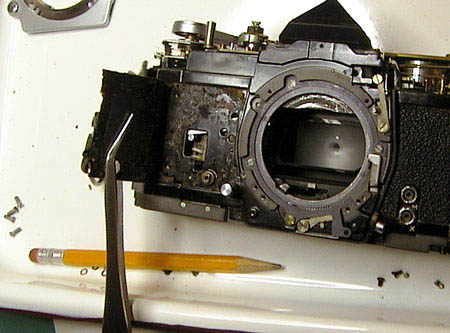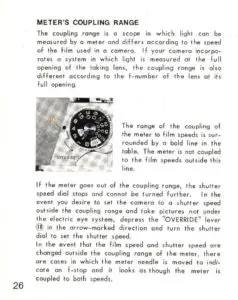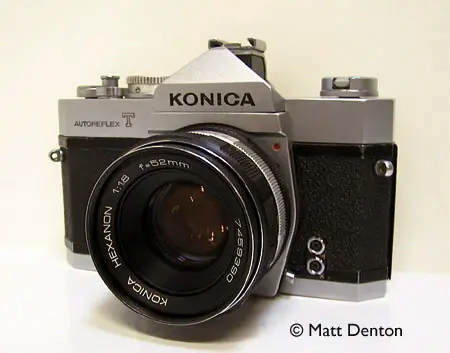- Produced T 1968-70 Konishiroku Co., Japan
- Film type 135 (35mm)
- Picture size 24mm x 36mm
- Weight 26oz (737g) body only; 34oz (964g) with 1.8 52mm lens — OOF!
- Lens Konica bayonet mount Hexanon AR 1.8/52mm (6 elements in 5 groups)
- Filter size 55mm
- Focal range 18″ to infinity
- Shutter Hi-Synchro Copal Square S (metal focal plane)
- Shutter speeds B, 1-1/1000
- Viewfinder SLR
- Exposure meter Center-weighted battery-operated TTL dual CdS metering with match needle
- EV Range 1.5 – 18 @ ASA 100
- ASA range 25-1600
- Battery two 675 (for meter and EE function)
- PC X and M sync, optional accessory shoe (shown)
- Self-timer
Overview
The Autoreflex T is the camera that planted Konica firmly on the SLR map. Solid, dependable, refined, with full manual or EE auto exposure. Legendary Hexanon lens. They had several previous designs but the Autoreflex T was their big hit and can still be found in usage today. Had three choices for normal lens: 52mm 1.8 (this one), 57mm 1.4 (!), and 57mm 1.2 (!!) Following the T was a similar model commonly known as the T2 but simply marked T, which was actually a slightly upgraded version of the T. It is noted by its on-off switch on the top instead of the back of the top cover (and a few other minor changes). The later T3 had a hot shoe and a host of further refinements that make it somehwat more well-rounded but make no mistake this T is a nice, heavy-duty, well-made camera. Built like a tank! The Zenits are frequently described as ‘robust’ but I’ll bet my Konica can beat up your Zenit!
For me this camera is notable for being my first non-Pentax mount camera. I had been deliberately avoiding a third SLR system, having two distinct ones already: Pentax K (bayonet mount) and M42 screw mount – often referred to as Pentax screw mount as it became popular with the early Spotmatics, even though it had been in use for years on Exacta/Praktica. Konica had its own distinct bayonet mount system. The later TC accepted these earlier AR lenses as well as the later ‘electric’ lenses like the 50mm/1.7 designed for the TC. I took the advice in the back of the Autoreflex T manual and got an adapter so that this bad boy can take M42 screw mount lenses, unfortunately (as with all lens mount adapters) that results in stopped-down metering — no auto-aperture diaphragm operation is available with an adapter 🙁
Repairs
Had a jammed shutter, some debris in the viewfinder window and the lens filter ring rattled a bit. Dirty. Appears to be well-used if you know what I mean. The word ‘beater’ comes to mind. PS here – an old toothbrush does wonders for a dirty camera, I don’t think it’s even possible to scratch the finish with one and boy does it get the gunk out of those hard-to-reach places. I can’t recommend one highly enough for cleaning cameras.
Various advice led me to begin a complete teardown of the camera in order to fix the shutter. I got far enough to see the mechanisms inside working and not, and realized I could trip the cocked shutter by pressing a lever that should have been tripped by the shutter release rod, which was stopping just as it got there. I looked under the bottom cap and noticed a wire spring that had come off its pin, preventing a sliding metal lever from moving out of the way of the shutter rod and stopping it before it could trip the shutter. I moved the spring back in place with a tweezer and boom the camera was working again. I was dumbfounded to see that such a small, seemingly insignificant piece of wire moved out of place by 1/4″ could jam the whole camera! But that’s cameras for ya. I cleaned up the pentaprism while I was at it. Very glad I drew a diagram of the pieces as I took them apart, fairly complicated.

SPECIAL NOTE on disassembling the lens mount – like on some Zeiss and Pentax cameras, the lens mount here is hand-shimmed with little washers, individually per camera, to make the mount perfectly parallel to the focal plane (see them under the pencil in the above illustration). CAREFULLY note the placement of these washers, they are of differing numbers and thicknesses and if you put them back wrong your lens will never be able to correctly focus onto the film. Ouch.
The rattling lens was the metal nameplate ring, which screws in (no spanner slots) and was simply loose. Beauty.
Tips & Tricks
Film loading tip: the takeup spool has an interesting rotating spool-within-a-spool, if you were to jam the end of the film in the grooves you could risk tearing the film or stripping out the rewind knob set screw when you rewind. Instead, all you need to do is put the end of the film in the groove till it stops, and wind on. The two spools will then rotate together and tightly grip the film leader.
 Other tips: No hot shoe, but two PC ports for X and M sync. Interesting ‘override’ switch on the shutter speed selector, I guess to make you think twice about going outside of the meter’s EV range. In fact this was difficult to find out as the only manuals I could find were for the T2 which doesn’t have this switch, but one of the friendly folks from the Yahoo Konica SLR Group emailed me a page from the T1 manual (see insert.) But the best tip: back door release is a lever on the bottom left of the camera (from the back) like some of the other late 60s SLR and rangefinder cameras, so don’t bust off your rewind crank trying to lift it up to get the door open! (It’s been known to happen.)
Other tips: No hot shoe, but two PC ports for X and M sync. Interesting ‘override’ switch on the shutter speed selector, I guess to make you think twice about going outside of the meter’s EV range. In fact this was difficult to find out as the only manuals I could find were for the T2 which doesn’t have this switch, but one of the friendly folks from the Yahoo Konica SLR Group emailed me a page from the T1 manual (see insert.) But the best tip: back door release is a lever on the bottom left of the camera (from the back) like some of the other late 60s SLR and rangefinder cameras, so don’t bust off your rewind crank trying to lift it up to get the door open! (It’s been known to happen.)
EE automatic aperture priority metering using the AR lenses, very nice. Has on-off switch for the meter to save batteries. Now, you would think I wouldn’t have to mention this, but judging by my test roll I guess I do – if you want to use the EE function, make sure the switch is set to ON. Heh. Also because of the voltage difference between the 625 mercury replacements and the original 1.3v mercury batteries this camera took, it’s good to set your ASA to lean towards 1/2-1 stop overexposure. For 100 speed film set it to ASA 80 or some such thing. Or use 1.4v hearing aid batteries.
Can’t believe I originally forgot to mention this: the camera does EE exposure, but the viewfinder readout is different than most SLRs of this vintage: the needle reads not correct but ACTUAL exposure on a scale that shows the f-stop appropriate to your shutter and film speed. It takes a little getting used to if you’ve been using regular match needle hi-lo metering. Also the scale goes from wide open at the top to stopped down at the bottom, and automatically (and mechanically) adjusts its range to the aperture range of your vintage EE lens. Amazing.
Related Links
- The brilliant Konica SLR User’s Pages in their new home
- Here is the manual in html format (for T2 but close)
- Nice German fellow Andreas has scanned manuals on his cool Konica site
